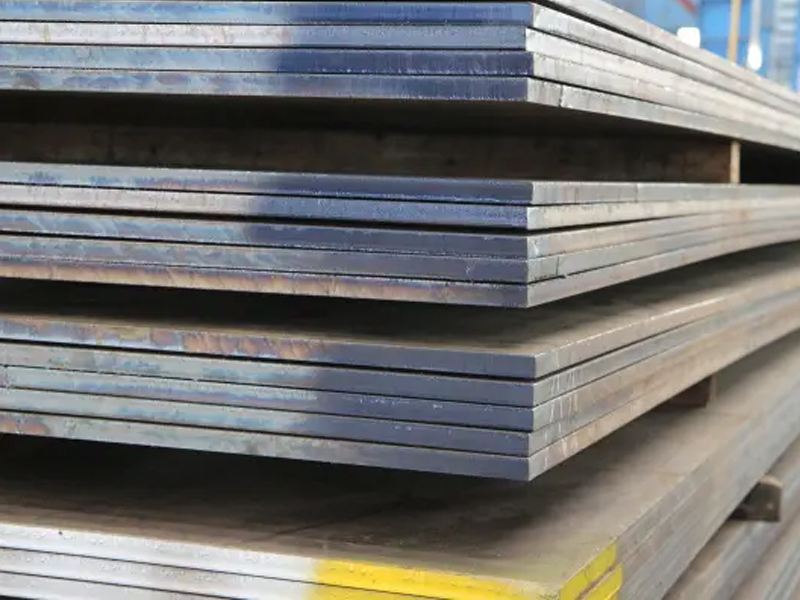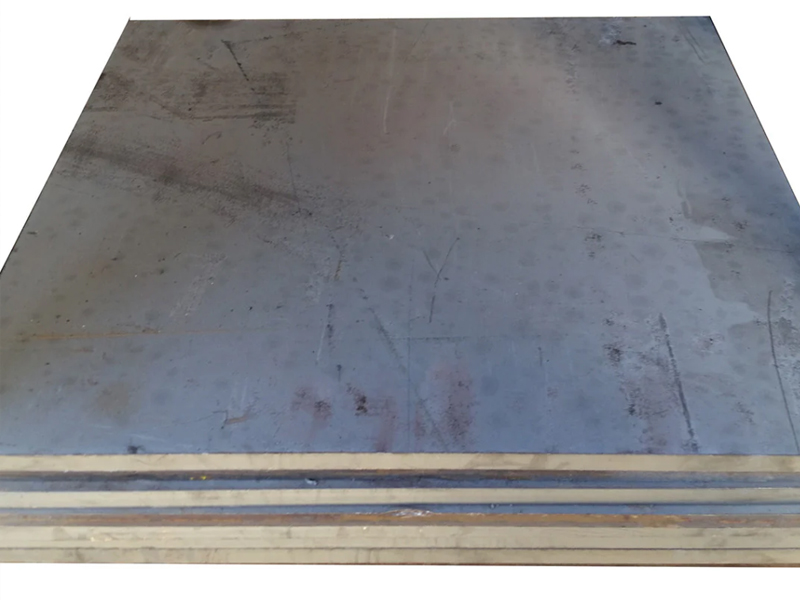product
The surface of hot-rolled steel sheet is rougher than that of cold-rolled steel sheet. If galvanized, it can also be used in scenarios where corrosion resistance is required. High strength and highly formable hot rolled steel sheets are also easy to drill, form and weld. Huangshangyou’s hot-rolled products are produced according to a variety of common standards, ranging from general purpose to high-strength steels, with pickled and non-pickled surfaces.
The surface of hot-rolled steel sheet is rougher than that of cold-rolled steel sheet. If galvanized, it can also be used in scenarios where corrosion resistance is required. High strength and highly formable hot rolled steel sheets are also easy to drill, form and weld. Huangshangyou’s hot-rolled products are produced according to a variety of common standards, ranging from general purpose to high-strength steels, with pickled and non-pickled surfaces.

Hot rolling usually adopts large ingots and large weight reduction rolling, which not only improves the production efficiency, but also creates conditions for increasing the rolling speed and realizing the continuous and automation of the rolling process. The advantages of hot rolled steel sheet include: increased ductility, wide application range, high productivity, and lower cost than cold rolled.
Hot-rolled steel typically requires fewer steps than cold-rolled steel, and therefore costs less. But since the hot rolled steel sheet can be cooled at room temperature, it is not affected by the internal stress generated during quenching or work hardening. Hot rolled steel sheets can be identified by the following characteristics:


S235 JR, S235 JRG2, S235 J0, S235 J2,
S275 JR, S275 J0, S275 J2,
S355 JR, S355 J0, S355 J2, S355 J2G3, S355 J2G4, S355 K2, S 355 K2G3, S355 K2G4 Q235, Q355
S355 J0:Structural grade S, minimum yield strength 355N/mm2, J0 grade confirms that the steel passes the longitudinal Charpy V-notch impact test at 0°C, 27J.
S355 J0+AR:Structural grade S, also with a yield strength of 355 N/mm2, but in rolled form.
S355 J0+N:Structural class S, also with a yield strength of 355N/mm2, but supplied in the normalized condition.
S355 is widely used in structural engineering and construction industry, and the workability of S355 J0 structural steel and marine steel plate is similar to that of low carbon steel, and it also has excellent weldability and good impact resistance.
Q235 steel plate has good plasticity, toughness, weldability and certain strength, and has good cold bending performance.
Q355 steel plate has good mechanical properties, welding properties, hot and cold processing properties and corrosion resistance, and can be used to manufacture welded structures with high loads such as ships, boilers, and bridges.
| thickness | width | length | standard | technology |
| 1~200mm | 1000~1500mm | 1000~12000mm | EN 10025-2:2004 | hot rolled |
| grade | Chemical composition not greater than Max.(%) | ||||
| C | Si | Mn | P | S | |
| Q235A | 0.22 | 0.35 | 1.4 | 0.045 | 0.05 |
| Q235B | 0.2 | 0.35 | 1.4 | 0.045 | 0.045 |
| Q235C | 0.17 | 0.35 | 1.4 | 0.04 | 0.04 |
| Q235D | 0.17 | 0.35 | 1.4 | 0.035 | 0.035 |
| Q355A | 0.2 | 0.5 | 1.7 | 0.035 | 0.035 |
| Q355B | 0.2 | 0.5 | 1.7 | 0.035 | 0.035 |
| Q355C | 0.2 | 0.5 | 1.7 | 0.03 | 0.03 |
| Q355D | 0.18 | 0.5 | 1.7 | 0.03 | 0.025 |
| Q355E | 0.18 | 0.5 | 1.7 | 0.025 | 0.02 |
| grade | Chemical composition not greater than Max.(%) | ||||||||
| C | Si | Mn | P | S | N | Cu | |||
| t≤16 | 16<t≤40 | t>40 | |||||||
| S275 JR | 0.21 | 0.21 | 0.22 | N/A | 1.5 | 0.035 | 0.035 | 0.012 | 0.55 |
| S275 J0 | 0.18 | 0.18 | 0.18 | N/A | 1.5 | 0.03 | 0.03 | 0.012 | 0.55 |
| S275 J2 | 0.18 | 0.18 | 0.18 | N/A | 1.5 | 0.025 | 0.025 | N/A | 0.55 |
| S355 JR | 0.24 | 0.24 | 0.24 | 0.55 | 1.6 | 0.035 | 0.035 | 0.012 | 0.55 |
| S355 J0 | 0.2 | 0.2 | 0.22 | 0.55 | 1.6 | 0.03 | 0.03 | 0.012 | 0.55 |
| S355 J2 | 0.2 | 0.2 | 0.22 | 0.55 | 1.6 | 0.025 | 0.025 | N/A | 0.55 |
| S450 J0 | 0.2 | 0.2 | 0.22 | 0.55 | 1.7 | 0.03 | 0.03 | 0.025 | 0.55 |
| grade | Yield strength not less than Min. (N/mm2) | tensile strength | Elongation not less than Min. (N/mm2) | Impact test | |||||
| t≤16 | 16<t≤40 | 40<t≤60 | (N/mm2) | t≤40 | 40<t≤60 | 60<t≤100 | Temperature (℃) | Energy Min. (J) | |
| Q235A | 235 | 225 | 215 | 375~500 | 26 | 25 | 24 | N/A | N/A |
| Q235B | 235 | 225 | 215 | 375~500 | 26 | 25 | 24 | 20 | 27 |
| Q235C | 235 | 225 | 215 | 375~500 | 26 | 25 | 24 | 0 | 27 |
| Q235D | 235 | 225 | 215 | 375~500 | 26 | 25 | 24 | -20 | 27 |
| Q355A | 355 | 335 | 325 | 470~630 | 20 | 19 | 19 | N/A | N/A |
| Q355B | 355 | 335 | 325 | 470~630 | 20 | 19 | 19 | 20 | 34 |
| Q355C | 355 | 335 | 325 | 470~630 | 21 | 20 | 20 | 0 | 34 |
| Q355D | 355 | 335 | 325 | 470~630 | 21 | 20 | 20 | -20 | 34 |
| Q355E | 355 | 335 | 325 | 470~630 | 21 | 20 | 20 | -40 | 34 |
When thickness t=16
| grade | Yield strength not less than Min. (N/mm2) | tensile strength | Elongation not less than Min. (N/mm2) | Impact test | |||||
| t≤16 | 16<t≤40 | 40<t≤60 | (N/mm2) | t≤40 | 40<t≤60 | 60<t≤100 | Temperature (℃) | Energy Min. (J) | |
| Q235A | 235 | 225 | 215 | 375~500 | 26 | 25 | 24 | N/A | N/A |
| Q235B | 235 | 225 | 215 | 375~500 | 26 | 25 | 24 | 20 | 27 |
| Q235C | 235 | 225 | 215 | 375~500 | 26 | 25 | 24 | 0 | 27 |
| Q235D | 235 | 225 | 215 | 375~500 | 26 | 25 | 24 | -20 | 27 |
| Q355A | 355 | 335 | 325 | 470~630 | 20 | 19 | 19 | N/A | N/A |
| Q355B | 355 | 335 | 325 | 470~630 | 20 | 19 | 19 | 20 | 34 |
| Q355C | 355 | 335 | 325 | 470~630 | 21 | 20 | 20 | 0 | 34 |
| Q355D | 355 | 335 | 325 | 470~630 | 21 | 20 | 20 | -20 | 34 |
| Q355E | 355 | 335 | 325 | 470~630 | 21 | 20 | 20 | -40 | 34 |
